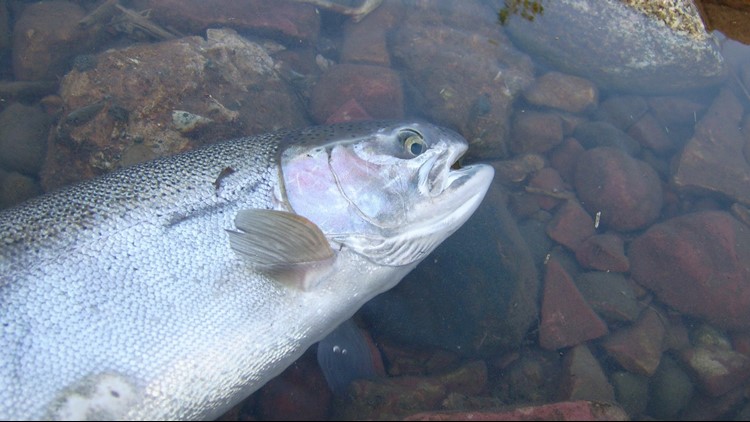SEATTLE — Last month, a net pen used for fish farming and operated by Cooke Aquaculture Pacific began to dip below the surface off Bainbridge Island.
A hole in a pontoon left the structure's southeast corner partially submerged. Repairs were eventually made.
But now as Cooke seeks to farm steelhead trout — instead of the nonnative Atlantic salmon that state law will soon ban — the incident has caught the attention of state regulators.
The events recalled the hectic summer of 2017, when hundreds of thousands of Atlantic salmon escaped a similar Cooke structure in the Salish Sea. Tribal fishers described it as a "devastation." Wildlife officials called for open season on escapees. The state's Department of Natural Resources (DNR) eventually terminated some Cooke leases and its ecology department fined the company $332,000 over water-quality violations, before the state Legislature in March 2018 voted to phase out the farming of nonnative fish — including Atlantic salmon — in Washington waters.
No fish escaped from the pen last month, according to Joe Smillie, DNR spokesman. The site still hosts Atlantic salmon, but they were in pens unaffected by the leak. Divers repaired a dime-sized hole in the pontoon. DNR is investigating.
For critics, however, the partially submerged pen was pink meat in their fight over fish farming.
"Risky business," said Kurt Beardslee, of the Wild Fish Conservancy.
"They're interfering in our fishing areas," said Merle Jefferson, executive director of the Lummi Nation's Natural Resources Department, adding that Cooke was lucky to have avoided another escape.
Cooke must cease raising Atlantic salmon here in 2022. The Washington Department of Fish and Wildlife (WDFW) last month proposed to issue a five-year aquaculture permit to Cooke for steelhead. The proposal is out for public comment through Nov. 22.
As the company pivots, opponents say it faces an uphill battle to gain public trust. The WDFW proposal represents Cooke's first attempt to convince regulators it can put its troubled past behind and continue farming here.
Cooke has applied to raise mostly sterile steelhead, or seafaring rainbow trout, in floating net pens at seven sites in Washington.
A Pierce County company, Troutlodge, would supply only female fish eggs. Eggs would be subjected to pressure to force them to retain a third set of chromosomes, making the fish triploid and sterile. Troutlodge claims a 99.83% sterilization rate, according to environmental documents Cooke filed with WDFW.
Captive triploid steelhead are often shaped like footballs, with smaller heads and stout bodies, the documents say.
As with Atlantic salmon, Cooke plans to feed the fish with pellets in open-air pens. The steelhead would take about 12 to 18 months to grow before they are harvested at a target weight of 7 to 9 pounds.
Cooke needs more permits to begin operations.
At some sites, Cooke would require new aquatic lands leases from DNR. Cooke is suing over DNR's cancellation of its Port Angeles lease. DNR also cancelled its Cypress Island lease.
Cooke must amend water-quality permits with the state Department of Ecology to reflect the proposed change of species. In addition, the company needs another WDFW permit every time it seeks to move fish from hatcheries to pens, said Ken Warheit, supervisor of fish health and molecular genetics for the state.
The company declined comment.
Cooke's critics have many concerns.
Beardslee said viruses, parasites and diseases could be amplified by dense groups of net-pen fish and spread to free-swimming populations of trout and salmon. He questions the structural integrity of Cooke's pens and worries fish could escape en masse again, interbreed with wild steelhead and put "thousands of years of genetic diversity we have at stake." Beardslee compared net-pen pollution to a ranch where "cattle are pooping right into the water."
Fish farming should not be allowed in Puget Sound where we're "spending hundreds of millions of dollars" to clean up, he said.
"The only way you can stop these from being a threat to the surrounding environment is to move them on land."
Beardslee said WDFW should complete a lengthy, detailed environmental impact statement for Cooke's proposal, rather than merely updating the 1990 document that originally allowed fish farming.
Warheit said risks to trout stocks in the natural environment would be low and could be largely mitigated with measures required by the agency.
Cooke's pens must be inspected by structural engineers every two years by law, Warheit said.
"If we feel the net pens do not have structural integrity, we will not permit fish in those net pens," Warheit said. The agency would consider the leaky pontoon incident as it weighs a final decision on the proposal.
He said Cooke's fish would be tested and vaccinated for IHN, a virus that could affect free-swimming steelhead and salmon, and other viral pathogens, too. Local sourcing of native eggs removes many concerns about introducing new pathogens to Salish Sea steelhead, he said.
Escaped captive steelhead would face challenging hurdles to reproduction, Warheit said.
Of escapees, just 0.2% would be fertile, he said, adding that the triploid fish would be less able to survive in the natural environment because of their captive upbringing.
"These fish have had no experience. No idea how to eat natural food. In many respects, that could have been bred out of them," he said.
The fish would likely need to survive for several months, or perhaps a year, to reach sexual maturity. Then, they would need to migrate into a freshwater system during a steelhead run, dig a redd, or a nest for eggs, and be discovered by a fertilizing male.
"I can't say it's impossible. Nothing's impossible, but the risk is extremely low," Warheit said.
Independent scientists backed much of Warheit's analysis.
Andrew Dittman, a research fisheries biologist for Northwest Fisheries Science Center, said using triploid fish was a common and largely effective process for maintaining a sterile population.
However, he cast doubt on Cooke's suggestions that farmed fish would struggle to find spawning grounds, saying studies on the topic have produced mixed results.
"I wouldn't necessarily assume they're just going to sit in Puget Sound and do nothing," Dittman said.
Rachel Breyta, a viral and molecular epidemiologist at the University of Washington's School of Aquatic and Fishery Sciences, said a trout-specific form of the deadly IHN virus has never reached Puget Sound.
"This is the major risk associated with farming steelhead in Puget Sound," Breyta said. "If fish or eggs have that virus or move to Puget Sound without testing or checking, it could introduce that pathogen into the water in a naive system."
The virus kills juvenile trout and has no treatment after disease begins.
But Breyta said the vaccine for IHN is effective. Careful management and state regulation "can bring the risk down very low."
If an infectious epidemic were discovered, what marine fish farms typically do is cull the entire infected population to prevent "amplification" of the virus in a dense grouping of fish, Breyta said. In an epidemic infection, "all populations would be at risk of serious mortality now and in the future."
In other words: The risk is low, but consequences could be severe.
Viruses can evolve rapidly and will require careful monitoring, Breyta added.
Jim Winton, a senior scientist emeritus at the USGS Western Fisheries Research Center, said past movement of aquaculture fish worldwide has spread diseases.
Winton shared Breyta's opinion that risks were low with known killers like IHN, but estimated that hundreds of viruses in fish have yet to be discovered.
"It's almost the unknown stuff I'm more worried about," he said.



